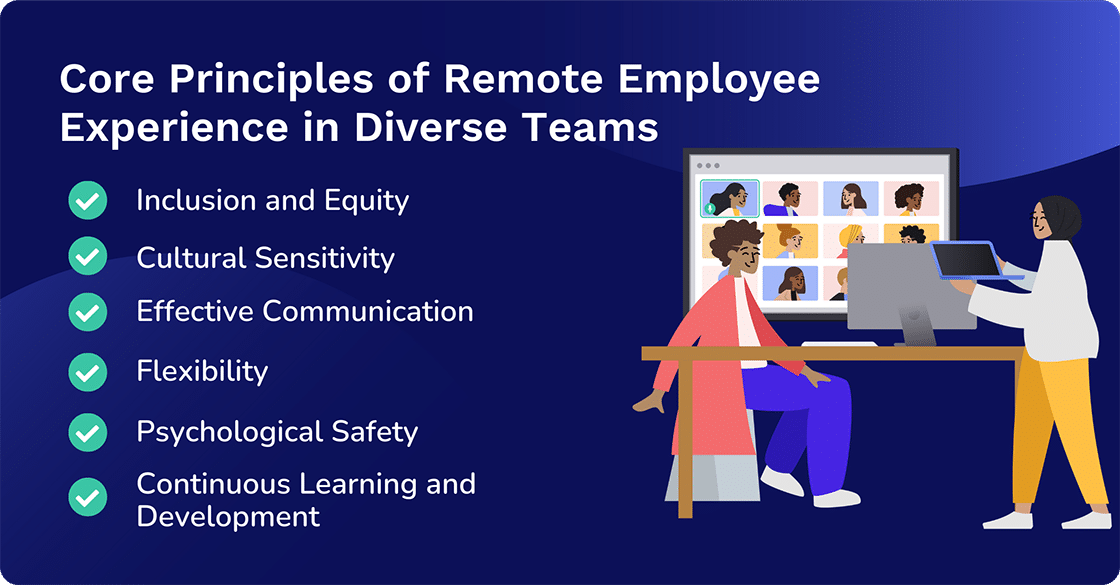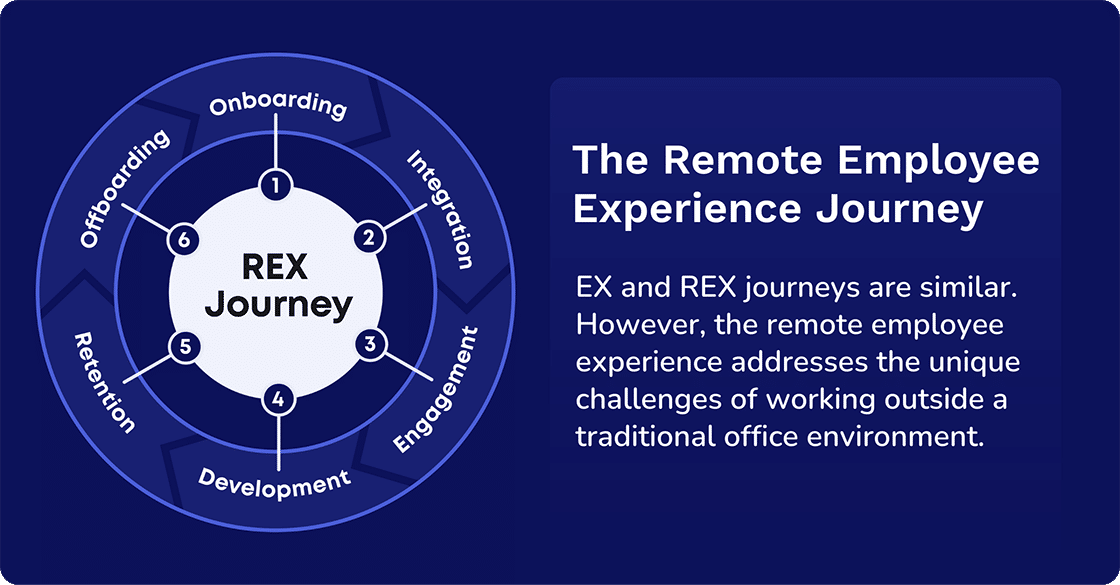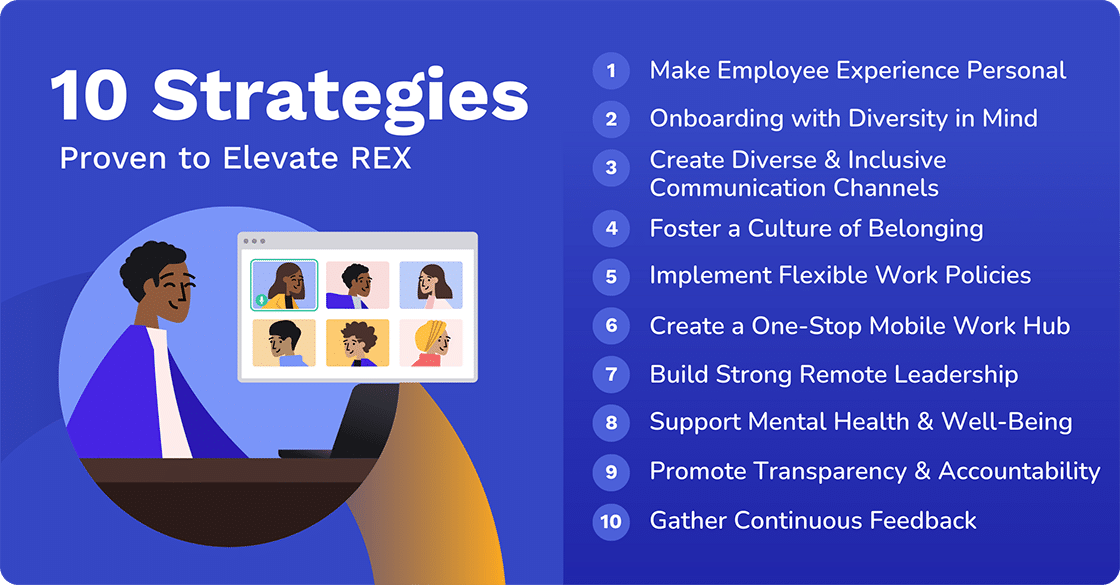A diverse remote employee experience addresses key challenges that face employees who work outside a traditional additional office environment. Well tell you how.

.png)
It can be difficult to know what to include in an employee survey. That’s why we have created a template that you can use for FREE to ensure your employee surveys are engaging. Get the responses that will help you understand your audience.
Access NowCreating a diverse remote employee experience (REX) is important because it ensures that all remote workers, regardless of their background, location, or personal circumstances, feel included, valued, and supported. A diverse approach fosters innovation. It also improves employee engagement and helps address the unique needs of a global and varied workforce. Ultimately, this leads to better organizational outcomes.
The perception of remote work continues to be hugely positive even though the number of remote employees has decreased since the peak of the COVID-19 pandemic.
According to Buffer’s 2023 State of Remote Work report, 98% of remote workers worldwide want to work remotely (at least some of their time) for the duration of their careers. Another 98% are happy to recommend remote work to others. Overall, 91% agree they have had positive experiences when working remotely. Only 1% identified negative remote work experiences, and 8% didn’t have an opinion.

Looking at this from a company’s stance, 71% of them are allowing some type of remote work on a permanent basis.
Zendesk EX Trends 2024 acknowledges that flexible workplace arrangements remain popular. However, 60% of the HR and IT leaders who participated in their survey agree that remote work has made it difficult to maintain the same level of productivity achieved before the pandemic. Even more (66%) affirm it has been difficult to monitor and evaluate the performance of their remote employees.
In this post, we’re going to explore the remote employee experience and how it differs from the more traditional employee experience (EX). We will consider the respective remote employee experience and traditional employee experience journeys. Then, we will identify 10 strategies that will help you improve communication and collaboration and create a diverse remote employee experience.
Remote employee experience is the overall perception and satisfaction of employees working in a remote or virtual environment. It includes how they interact with colleagues, access resources, maintain productivity, and feel connected to the company's culture while working outside a traditional office setting.
Here are six core principles:

Remote employee experience differs from employee experience in its focus and context. While EX encompasses the overall experience of all employees within an organization, including those in physical offices, REX specifically addresses the unique challenges and needs of employees working remotely. REX emphasizes factors like virtual communication, remote collaboration tools, work-life balance in a home environment, and maintaining connection and engagement without physical presence. EX covers broader aspects like office culture, physical workspace, and in-person interactions.
Craft effective surveys to measure employee sentiment and boost engagement
.png)
EX and REX journeys are similar. However, the remote employee experience addresses the unique challenges of working outside a traditional office environment.
Both typically follow several key stages.

In a typical EX, onboarding may involve in-person orientations, tours of the physical workspace, and face-to-face meetings. In REX, onboarding is entirely virtual, requiring more intentional communication and the use of digital tools to help newly hired remote employees connect with their team and understand the company culture.
Senior executives may require a more strategic and comprehensive introduction to the company's high-level goals. Less experienced employees need a more detailed orientation that focuses on day-to-day tasks.
For in-office employees, integration often happens organically through everyday interactions and physical proximity. In contrast, REX requires structured virtual activities, scheduled check-ins, and deliberate efforts to build relationships and foster a sense of belonging, remotely.
Experienced employees might integrate more quickly due to their familiarity with industry practices. Entry-level employees may need more hands-on support, structured mentorship, and more frequent check-ins to build confidence and competence in a remote setting.
Traditional employee experience benefits from spontaneous, in-person interactions and social activities that naturally boost engagement. Remote employee experience, on the other hand, relies on virtual team-building activities, online collaboration tools, and regular remote communication to keep employees engaged and connected.
For executives, engagement often involves strategic involvement and leadership in virtual meetings. Junior employees might engage more through participation in team activities and receiving feedback on their work. Tailoring engagement strategies to different levels ensures that all employees feel valued and motivated.
While both EX and REX focus on career growth, REX must account for the lack of physical presence in networking and mentorship opportunities. Remote employees may need more access to online learning platforms and virtual career development resources to ensure they can progress at a similar pace to their in-office counterparts.
The remote employee experience journey also diverges from the traditional employee experience in how it addresses development across different levels of employees. Experienced executives may require tailored virtual leadership programs and strategic networking opportunities, while entry-level employees or those with minimal experience often need more structured guidance, mentorship, and access to skill-building resources that accommodate the nuances of remote learning. This distinction is crucial to ensuring that both seasoned leaders and newer employees thrive in a remote environment.
Retention strategies in a traditional EX might include perks like office amenities or in-person recognition events. In REX, companies need to focus more on flexibility, remote work support, and maintaining strong virtual communication to keep remote employees feeling valued and connected.
Retention efforts for executives may focus on leadership opportunities, influence over company direction, and executive-level support, while for less experienced employees, retention may hinge on continuous learning opportunities, career progression paths, and strong mentorship programs.
It is also a good idea to incorporate a well-structured hardware asset management lifecycle. This will ensure that remote employees have access to the necessary equipment, creating a seamless and efficient work experience.
Offboarding in a traditional EX might include in-person exit interviews and farewells. In REX, this process is conducted virtually, requiring more attention to detail in ensuring a smooth handover of responsibilities and maintaining a positive relationship post-departure. Either way, respectful and organized offboarding helps maintain positive relations and leaves the door open for future collaboration.
Executive offboarding often involves detailed succession planning and knowledge transfer to ensure continuity. For junior employees, it may be more focused on ensuring a smooth transition of tasks and learning from their experiences for future improvement in onboarding processes.
Craft effective surveys to measure employee sentiment and boost engagement
.png)
Effective communication and collaboration in remote teams are crucial for maintaining productivity and cohesion across geographically dispersed members. By implementing strategies to enhance transparency, inclusivity, and engagement, companies can overcome the challenges of remote work. This will help to build strong, connected teams of remote workers that thrive in a virtual environment.
This means that both collaboration and communication are critically important when you create a diverse remote employee experience. Here are 10 strategies to help you succeed.
A mobile app featuring a central repository for company news is unlikely to engage employees unless you personalize the mobile app experience. You can do this with specific news offerings based on what remote employees need to know plus what they have explicitly told you what they want to hear more about. Commonly, adoption will increase exponentially. When information is relevant to employees based on role, team/business unit, and personal interests such as volunteer opportunities, health and wellness, or professional development, employees will continue to engage.
Onboarding with diversity in mind involves creating an inclusive and welcoming experience for new hires from all backgrounds. This is crucial for improving communication and collaboration with remote workers. It ensures that every employee feels valued and supported from day one. This necessitates:
By recognizing and addressing the unique experiences of each new employee, organizations can promote a sense of belonging and set the stage for a positive and productive remote employee experience.
Creating diverse and inclusive communication channels is essential for improving collaboration among remote workers. Companies can achieve this by using accessible platforms that accommodate all employees. Be sure to include those with disabilities by providing tools that incorporate screen readers and adjustable text sizes. Promoting open and respectful dialogue through clear communication guidelines and inclusive language will ensure that everyone feels respected and understood. Offering multiple communication options, such as video calls, messaging apps, and emails, allows employees to engage in ways that best suit their preferences and needs.
This is crucial for enhancing remote team communication and collaboration. It begins by creating an environment where every employee feels valued and included. You can achieve this through transparent diversity and inclusion policies, celebrating various cultural events, and encouraging open dialogue about individual experiences. Regular team-building activities and recognition programs that highlight diverse contributions help strengthen community and mutual respect among remote employees.
Additionally, providing tailored professional development and mentorship opportunities supports employees’ growth and ensures they feel valued. Encouraging leaders to model inclusive behavior and regularly seeking feedback on inclusivity initiatives helps maintain and adapt the culture of belonging to meet evolving workforce needs. By embedding these practices into everyday operations, companies can cultivate a strong, inclusive culture that fosters effective collaboration and a sense of belonging among all remote employees.
Implementing flexible work policies is key to enhancing remote team communication and collaboration. These policies can include options for flexible working hours, varied work locations, and adjusted deadlines to accommodate different time zones and personal circumstances. Providing employees with the autonomy to manage their work schedules helps them balance their professional and personal lives, leading to increased job satisfaction and productivity.
Additionally, flexibility in work arrangements supports diverse needs and preferences, promoting a more inclusive environment.
When deploying an employee engagement app, we should look at consumer research. There’s often a disconnect between employees and customers. Before deploying an app, research how your employees are consuming company information. Find out what prompts them to open and read a piece of company news. Is it compliance-driven or do they engage with specific topics more than others? By pairing personalized news with critical self-service tools, you will be providing a platform focused on convenience. These features work in tandem to deliver a quality user experience by providing targeted information to employees along with interest-based content.
A study conducted by eMarketer suggested that adults spend most of their time on apps when utilizing a mobile device. US Mobile Time Spent 2020 revealed that in 2020, U.S. adults spent 3 hours and 43 minutes on their mobile devices every day. Of this time, 2 hours and 57 minutes were spent on mobile apps.
Statista shows how the daily time spent on mobile phones in the U.S. since 2019 has continued to rise. Not counting time spent talking on phones, by April 2022, it had reached a total of 4 hours and 30 minutes per user. The prediction is that the figure will reach 4 hours and 39 minutes this year (2024).
Assessing worldwide mobile app usage, Statista also reveals that after increasing in 2021, consumer spending on mobile apps decreased to US$167 billion in 2022. It came back on track in 2023, when it surged to US$171 billion.
Here’s something to think about. An employee communication app becomes powerful when time and attendance, expense reporting, employee directories, and collaboration tools like Slack or Microsoft Teams are added as features.
Building strong remote leadership is essential for effective communication and collaboration within distributed teams. Effective remote leaders actively engage with their teams through regular, transparent communication and provide clear direction and support. They leverage virtual tools to maintain visibility, offer constructive feedback, and ensure that team members feel connected and motivated, even from afar.
Strong remote leaders also prioritize the development of trust and accountability by setting clear expectations, recognizing achievements, and addressing challenges proactively. By fostering a culture of openness and providing ongoing professional development opportunities, leaders can build strong, cohesive teams that thrive in a remote environment. This approach not only enhances team performance but also supports a positive remote work culture where employees feel valued and empowered.
Supporting mental health and well-being is crucial for maintaining a productive and engaged remote team. Companies can offer resources such as access to virtual counseling services, wellness programs, and mental health workshops to help employees manage stress and maintain work-life balance. Encouraging regular breaks, promoting a healthy work environment, and providing flexibility for personal needs can also contribute to overall well-being.
Additionally, creating a supportive culture where employees feel comfortable discussing mental health issues and seeking help without stigma is essential. Leaders should model self-care practices and regularly check in with their teams to address any concerns and ensure that support systems are effective and responsive to employees' needs.
Promoting transparency and accountability is vital for effective remote team communication and collaboration. Companies can achieve this by clearly defining goals, responsibilities, and performance metrics, ensuring that all team members understand expectations and their role in achieving objectives. Regular updates and open sharing of information about company decisions, project statuses, and team performance foster trust and align efforts across the team.
Additionally, creating mechanisms for feedback and providing opportunities for employees to voice their concerns and suggestions helps maintain accountability and continuous improvement. Encouraging leaders to model transparency by being open about challenges and progress further supports a culture of accountability. By integrating these practices, companies can enhance communication, build trust, and drive performance in a remote work environment.
Feedback is essential for improving communication and collaboration within remote teams. Companies can implement regular check-ins, surveys, and anonymous feedback channels to understand employees' experiences, address concerns, and identify areas for improvement. This ongoing dialogue helps leaders stay informed about team dynamics and effectiveness, allowing for timely adjustments to policies and practices.
Additionally, creating a culture where feedback is actively sought and valued encourages employees to share their insights and suggestions openly. By acting on the feedback received and demonstrating responsiveness to employee needs, organizations can enhance team cohesion, optimize remote work processes, and foster a more engaged and productive workforce.

Measuring and improving remote employee experience is essential for ensuring that remote employees remain engaged, productive, and satisfied. Regular assessments through surveys, feedback sessions, and performance metrics help identify strengths and areas for improvement in the remote work environment. By analyzing this data and implementing targeted strategies, companies can address issues, enhance job satisfaction, and optimize remote work practices.
Ultimately, continuous evaluation and adaptation ensure that remote employees feel supported and valued, ultimately leading to reduced turnover and a more positive and effective remote work culture.
As a communications team, it’s essential to research how mobile push notifications will resonate with your employees. They must all qualify as must-see communications. Breaking company news, security alerts, important leadership updates, and messages requiring employees to take action are valid notifications. However, it’s crucial to look at the combination of potential notifications hitting mobile devices all within a compressed period. Too many notifications could negatively impact the user experience. It’s a balancing act. Internal communicators need to manage the proverbial runway as “air traffic controllers” to manage the number of push notifications.
Although it is difficult to manage this balance, it is much easier when you have the right tools.
Cerkl Broadcast’s mobile app is great for engaging remote employees. You don’t need IT, and you can use it for all employees whether they are office-based or working remotely. With push notifications, your remote workers will receive their employee communications instantly. No more cluttered inboxes and a great solution for time-sensitive updates regardless of where your remote employees are.
You will definitely benefit by signing up for Cerkl Broadcast to get your hands on our mobile app. But first, we want you to assess employee engagement levels in your organization. The good news is that you can measure remote employee experience through our free employee engagement survey.
.png)
Craft effective surveys to measure employee sentiment and boost engagement
What is remote employee experience? Remote employee experience (REX) refers to the overall perception and engagement of employees working remotely, including their interactions, well-being, and productivity in a virtual work environment. It encompasses factors like communication, technology, work-life balance, and company culture.
How to improve remote employee experience To improve the remote employee experience, companies should invest in robust communication tools. They should also provide regular feedback, foster a sense of belonging through virtual team activities, and ensure employees have the necessary resources to work comfortably from home.
How do employees feel about remote work? Employees generally appreciate the flexibility and autonomy of remote work. However, some may struggle with isolation, maintaining work-life balance, or feeling disconnected from their team.

Craft effective surveys to measure employee sentiment and boost engagement